History of the Carnival in Venice
The Venetian Mask is King
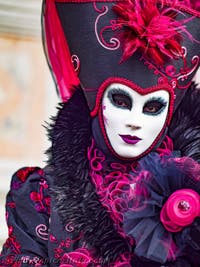
Venice Carnival If carnival was this single moment, when the fable and the comedy jostled the rules of the day, it was especially the holiday of the world upside down, the utter disorder and the feast.
The play and freedom of madness leads the dance of all carnivals. Except that in Venice, carnival becomes a way of life and a frame of mind!
The Republic authorized the mask, and it was protected by it.
As long as carnival lasted everybody carried the mask, the doge, and the priest, the nuncio and even the maidservant and was occupied with their business “incognito".
They were concealed as went shopping, visited, and went about their ordinary life; except that the mask made it possible say and do everything they dared!
The mask erased the social barriers: from etiquette to conventions to respect.
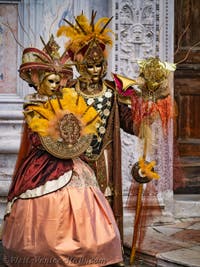
Venice Carnival No longer the patrician, the inquisitor, the priest or monk, the zentildonna, the foreigner, the nun, nor the rich or poor man. There wasn’t any bashfulness, or embarrassment; everything remained “A Masked Ball”.
The black cape (tabarro), the white bauta and the black dominoes under the tricorn hat were not sad: they were first of all signs of freedom of speech; it sanctioned folly, joy and secret pleasures. Nobody was indebted to anyone and nobody forbid anyone.
The only rule: have a good time, laugh, and dance and have fun with the group.
Venetian Masks and Characters
For costumes, the masks and figures of the Italian comedy gave them a wealth of characters, silhouettes and grotesque accessories: famous Harlequin and Pantalon, Punch, Brighella, Colombine, Scaramouche and so many others met, heckled and made their comedy on the place, others mingled, laughed and applauded, while Pierrot fell of the moon.But they could also dress up, and endorse the costume of any figure: jobs and style of those that exercised them, as well as all foibles of the human person inspired a lot of people.
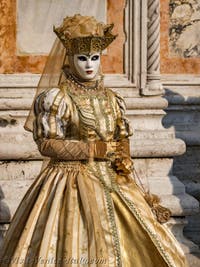
Venice Carnival They could be which they wanted: a miser, a tinker of saucepans, a charlatan, a lawyer, a beggar, a tooth-puller, a monk, a chimney sweeper, a trader of rat poison, but it was necessary to be able to support the performance of the one whose attire they sported.
A British traveller wrote:
“The lawyer has an argumentative tone, and the doctor has pedantic air.
They have a lot of animation in their language; those who have no talent to support it do not run the risk of it. Every man, whom you will meet in your path, is sure to be entertained here.
I heard more witticisms in this one day of conviviality than during week in quite other place.”
The art of the caricature and mockery showed the truth which made everybody laugh, including those who were portrayed, yet they also were letting off steam with a figure of their choice!
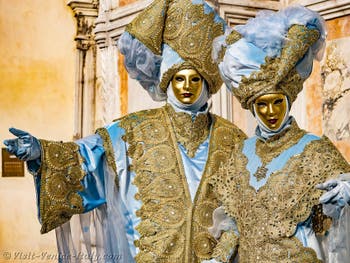
Venice Carnival Here is a devil followed by the seven deadly sins, a monk, a courtesan, a dervish, an Egyptian, a satyr, shameless French, a gang of Spanish lansquenets in full regalia, Spanish morticians, a doctor of the plague carrying the mask in the long beak filled with herbs who lifts the clothes of the sick with his staff, a seller of love potions, a mufti, a Calabrian on his donkey...
And “Illustrissimo”, ruined nobleman decked out in an immense wig and in a ridiculous morning coat, carrying the sword in the side, muddied bottoms and shoes with a hole, who gave to the passers-by his protection, its treasures and its palace.
Undoubtedly there were also deposed kings and princes, these princes of carnival whom Candide (Candide in Voltaire's story of the same name) met in the course of meal during the Venice carnival!
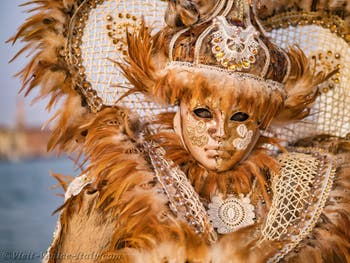
Venice Carnival Really, as in Candide, all is for the best in this, the best of all possible worlds, of the carnival, when Carlo Goldoni has been transformed and “sings histories of the Rive”.
They said then: "Nobody forges better than Goldoni the air, tone and grandiloquence of this kind of charlatans; it is its favorite fancy dress.”
The jeers, retorts went along with each other, each to control the qualities of his figure to give more pricking dialogues and to improvised scenes with other masks. The agile Venetians do not allow themselves to be content with merely wearing costume; they must embody the spirit as well.
Tradition - Carnival and Pleasures
Back to Top of Page

